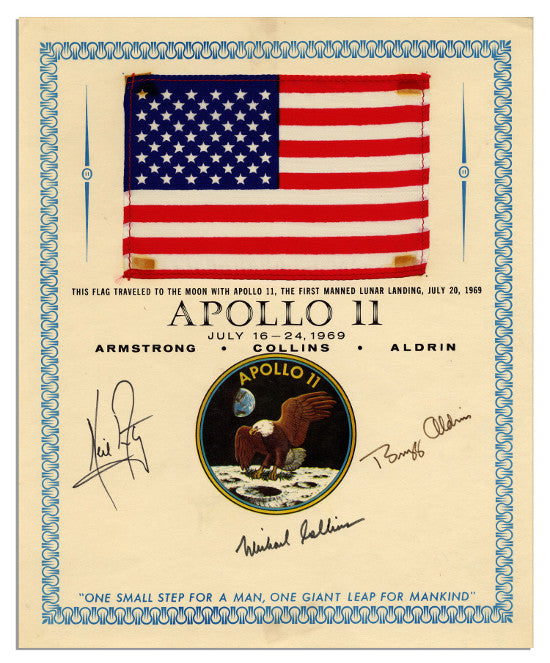From the very beginning of the American space programme, astronauts carried small souvenirs with them.
They were to be sold, or given to friends and family on their return to Earth.
On a spacecraft, every inch of space matters and any extra weight, however small the increase, can cause problems.
During the Gemini project (1961-1966) NASA introduced the PPK (Personal Preference Kit), a small drawstring bag given to each astronaut.
You could put anything you wanted in there (within reason).
As it measured just 5 x 8 inches and was permitted to weigh only 0.6kg, astronauts were forced to get creative with the items they took. There’s a thriving market out there for these small souvenirs today, and for other pieces carried aboard the missions.
Let’s take a look at the stories behind five items astronauts brought on their remarkable journeys.
Lunar Bibles
Astronaut Ed White was one of three crew members killed in the devastating fire that ripped through Apollo 1 as it sat on the launch pad on February 21, 1967.
A devout Christian and member of the Apollo Prayer League, he’d told his friends that his big dream was to take a Bible to the Moon.

Believe it or not, this 1 x 1 inch sheet is printed with the entire text of the bible
In the years after his death, NASA went to extraordinary efforts to make this happen. Using microfilm technology they were able to shrink the entire King James Bible down to a 1 x 1 inch square, meaning it can be read under a microscope.
One was carried on Apollo 12 in 1969, but was kept in the lunar module – so never made it to the lunar surface. The following year 512 were carried on Apollo 13. But disaster struck. The spaceship blew an oxygen tank and the crew were forced to return to Earth.
Finally, in 1971, Apollo 14 brought up 300 of those original 512. Edgar Mitchell managed to take 100 down to the lunar surface.
Few of those 100 are known to have survived. You can expect to pay in excess of $50,000 for one today.
US flags
Miniature US flags were the obvious choice for lunar missions.
They’re small, light and can be packed into tiny spaces.

These flags were attached to signed backings when the crews returned to Earth
In fact, most of the Apollo missions carried an Official Flag Kit bag. These were added by NASA rather than the astronauts themselves.
The flags were typically given as official gifts.
They usually come attached to a backing, signed by each of the astronauts on the mission.
While they’re more common than some of the other items on this list, they’re highly collectable. Buyers find the patriotic symbolism irresistible. Demand is highest for those carried on Apollo 11, which often go for in excess of $60,000.
Flown covers
Going into space using first generation technology was an absurdly dangerous thing to do.
So there weren’t many insurance companies lining up to underwrite astronauts back in the 1960s.

This is a controversial Apollo 15 Seider Cover (trust me, it's a story for another day)
One of the ways NASA made sure families would be provided for was to create a series of envelopes or "covers" (starting with Apollo 11), which each member of the crew would sign.
Stamp collecting was enormously popular at the time. Should the worst happen, the families could sell these pieces to collectors.
Crews started carrying a limited number of the covers with them into space.
Prices vary, depending on the mission. Apollo 11 flown covers are the most sought after, with the best pulling in prices of up to $60,000.
Miniature licence plates
The Apollo 15 mission introduced the Lunar Roving Vehicle (LRV), a wheeled vehicle that allowed astronauts to range further than they ever had before.

Boeing gave Apollo 15 commander Dave Scott these mini licence plates as a gift
To commemorate the occasion, Boeing (which built the Rover) released a series of miniature versions of the vehicle’s licence plate (LRV 001) measuring 1½ x ½ inches. The company gifted them to commander Dave Scott, who secreted them inside his space suit.
No one is sure quite how many there were. The number probably sits around 20.
Those that have sold have made between $12,000 and $16,000. Given its rarity, those figures are likely to increase over time.
Snoopy pins
The Silver Snoopy Award is given to NASA employees on the ground who have “greatly enhanced space flight safety and mission success”.
The prize has been running since 1968.

Charles Schulz himself designed this version of Snoopy especially for NASA (Image: Wikimedia Commons)
During the early years of the space race, these pins were flown. Whether that’s still the case is unclear.
They’re not exactly rare either. Around 12,000 people have received one since the late 1960s.
Still, they remain hugely popular with collectors – with prices for the rarest variants edging towards $15,000.
All the best,
Paul.
PS. You can take a look at my fabulous range of space memorabilia for sale here.






